高考英语阅读理解核心笔记(学生)
2023年全国甲卷英语a篇阅读理解

主题:2023年全国甲卷英语a篇阅读理解一、概述2023年全国卷英语考试是我国高考中的一项重要组成部分,阅读理解是英语考试中占比较多的题型,考生对于该部分的准备和应试技巧至关重要。
二、分析题型1. 阅读理解题型阅读理解题型占据了卷面中相当大的比重,主要考察考生对于文章细节、主旨、段落大意的理解能力,需要考生具备较强的阅读理解能力。
这一部分通常包括三篇短文,每篇短文后面都有几个问题需要考生回答。
2. 分析题型特点阅读理解题型的文章内容通常涉及各个领域,如教育、科技、文化、历史等,内容广泛。
同学们在备考时需要从不同领域的文章中获取相关信息,灵活运用自己的知识储备去解答问题。
三、备考策略1. 阅读速度阅读理解是考察考生阅读理解能力的题型,因此阅读速度是非常重要的。
考生在备考时可以多进行阅读练习,提高自己的阅读速度和理解能力。
可以选择一些英文杂志、英文小说进行阅读,培养自己的阅读兴趣和阅读习惯。
2. 预测题目在阅读文章之前,可以先浏览问题,了解问题的主题和题目所涉及的内容,再针对性地进行阅读,这样可以更快找到文章中相关信息,提高解题效率。
3. 提高词汇量阅读理解题型中难免会遇到一些生词,考生需要具备较强的词汇量和词汇理解能力。
备考阶段可以通过背单词、扩大词汇量的方式来提高自己的词汇水平。
四、实战模拟1. 针对性练习在备考阶段,考生可以通过解析历年的英语卷子来进行针对性的练习,熟悉题型,了解命题特点,提高解题效率。
2. 模拟考试可以在规定的时间内模拟真实考试环境,完成完整的一套试卷,检验自己的备考效果,找出不足,做针对性地提高。
五、备考心态1. 自信心备考阶段需要保持自信心,坚信自己的付出会有回报,在备考的过程中保持积极乐观的心态对备考是有益的。
2. 调整心态认真备考英语阅读理解,但不要过分焦虑,遇到困难时不要灰心丧气,要学会调整自己的心态,科学合理地备考。
六、结语2023年全国卷英语考试是考生进入理想大学的一个重要关口,英语阅读理解同样是该考试中的一个重要部分。
外研版高考英语一轮总复习 背诵默写本 必修第1册精品课件 Unit 1 A new start

学校生活
二、兴趣爱好 1.club n.社团,俱乐部 2.join v.参加,加入 3.science n.科学 4.director n.导演 5.star n.明星 6.guitar n.吉他 7.skill n.技能,技巧 8.teammate n.队友
三、人际关系 1.nervous adj.紧张的 2.face v.面对 3.introduce v.介绍 4.relaxed adj.放松的,自在的 5.patiently adv.耐心地 6.suggestion n.建议 7.sound adj.明智的,合理的 8.fantastic adj.极好的
(二)识记阅读词汇 1.campus n. 2.facility n. 3.engine n. 4.insect n. 5.poster n. 6.badminton n. 7.drama n. 8.band n. 9.gym n.
校园 设施 发动机,引擎 昆虫 海报 羽毛球 戏剧 乐队,乐团 体育馆,健身房
1. in panic 2. depend on 3. make the most of 4. deal with 5. in particular 6. at the sight of 7. look forward to 8. make a good first impression on
惊慌地 依赖,依靠 充分利用 处理,应付 尤其 一看到…… (兴奋地)期待,盼望 给……留下……好的第一印象
Unit 1 A new start
必修第一册
英语
教材单词
(一)必背重点词汇 1. senior adj.(地位、水平或级别)高的,高级的 2. moment n.某一时刻 3. author n.作者,作家 4. panic n.惊恐,惊慌 5. calm adj.镇静的,沉着的 6. debate n.讨论,辩论 7. topic n.话题,论题 8. sharp adj.敏锐的,聪明的 9. gain v.获得,赢得
高考英语一轮复习 第一 Module 4 W

入舵市安恙阳光实验学校Module 4 Which English Ⅰ.情景默写1.Across all media,people are debating(讨论) about whether we need to keep track of every school bus on China’s road.2.Topics for textbooks and conference books should be relevant(有关的) to the experiences and interests of the students.3.Everyone stood up instantly(一……就) the hero came into the lecture hall.4.How much you earn is not very important.It is how you earn the money that counts(很重要).5.A proper approach to improving the learning efficiency is of great significance(意义) to every student.6.The planned new airport was strongly opposed(反对) by the residents.7.I was convinced(确信的) that we were doing the right thing.8.She complained(抱怨) that no one had been at the airport to meet her.9.As we know,language is one of the significant means for mankind to convey(传达) thoughts and feelings.10.He couldn’t resist(抵制) laughing at the exciting news.11.Hobbies offer knowledge and relaxation.Furthermore(此外),they help improve one’s mental and phy sical health.12.This kind of flowers looks unique(独特的) because you can’t find it in other countries.13.The Eiffel Tower in Paris is an easily recognisable(可辨认的) landmark.14.Don’t lose heart,and you can overcome(克服) all the difficulties ahead.15.Before you get down to(开始做)any serious sporting activity,it is important to warm and stretch your muscles.16.In conclusion(总之),I would like to thank all those who have worked so hard to bring about this good result.17.I promised to go to the party with Jane and I can’t let her down(让她失望).18.Your dream will come true sooner or later as long as(只要)you do your best.Ⅱ.词性转换1.His convincing words finally convinced me,and I was convinced that he was innocent.(convince)2.Some scientists associate smoking with cancer,because smoking has a close association(associate) with lung cancer.3.To get more evidence,the lawyer investigated many witnesses.After investigation, he got some useful proof.(investigate)4.Most students think it significant(significance) to join the English corner,though a few haven’t realized the significance of it.5.Thanks to your approval(approve), if you didn’t approve of my plan,I would be fired by the employer.6.The child asked curiously, “Why does the moon move around the earth ?” We are curious to know why she asked such a question.Perhaps children show curiosity about everything.(curious)1.句型公式:whether...or...不论……还是……不管天气好坏,我们都会按计划出发。
高考英语 第一 Unit 1 Living well课下作业高三英语试题
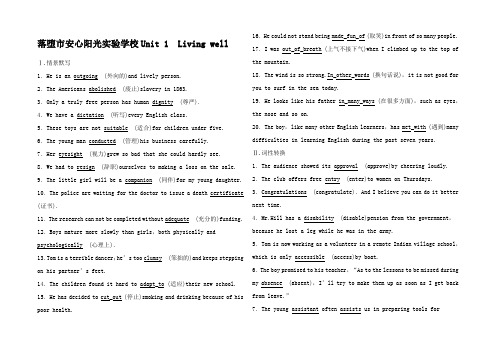
落堕市安心阳光实验学校Unit 1 Living wellⅠ.情景默写1.He is an outgoing (外向的)and lively person.2.The Americans abolished (废止)slavery in 1863.3.Only a truly free person has human dignity (尊严).4.We have a dictation (听写)every English class.5.These toys are not suitable (适合)for children under five.6.The young man conducted (管理)his business carefully.7.Her eyesight (视力)grew so bad that she could hardly see.8.We had to resign (辞职)ourselves to making a loss on the sale. 9.The little girl will be a companion (同伴)for my young daughter. 10.The police are waiting for the doctor to issue a death certificate (证书).11.The research can not be completed without adequate (充分的)funding. 12.Boys mature more slowly than girls,both physically and psychologically (心理上).13.Tom is a terrible dancer;he’s too clumsy (笨拙的)and keeps stepping on his partner’s feet.14.The children found it hard to adapt_to (适应)their new school. 15.He has decided to cut_out (停止)smoking and drinking because of his poor health.16.He could not stand being made_fun_of (取笑)in front of so many people. 17.I was out_of_breath (上气不接下气)when I climbed up to the top of the mountain.18.The wind is so strong.In_other_words (换句话说),it is not good for you to surf in the sea today.19.He looks like his father in_many_ways (在很多方面),such as eyes,the nose and so on.20.The boy,like many other English learners,has met_with (遇到)many difficulties in learning English during the past seven years.Ⅱ.词性转换1.The audience showed its approval (approve)by cheering loudly. 2.The club offers free entry (enter)to women on Thursdays. 3.Congratulations (congratulate).And I believe you can do it better next time.4.Mr.Hill has a disability (disable)pension from the government,because he lost a leg while he was in the army.5.Tom is now working as a volunteer in a remote Indian village school,which is only accessible (access)by boat.6.The boy promised to his teacher,“As to the lessons to be missed during my absence (absent),I’ll try to make them up as soon as I get back from leave.”7.The young assistant often assists us in preparing tools forexperiments.(assist)8.Robert is a very ambitious man and one of his ambitions is to travel in Antarctic.(ambition)9.My husband’s talking with full food in his mouth always annoys me.Although I am annoyed with him about his annoying habit,he can’t get rid of it.(annoy)10.As we all know,fresh air is beneficial to our health and the new park benefits us all,so we should keep it clean.(benefit)1.句型公式:too...(for sb.)to...意为“太……而(某人)不能……”说实话,他很固执,你说服不了他跟我们一起去。
高考英语 Unit 4 Global warming高英语试题
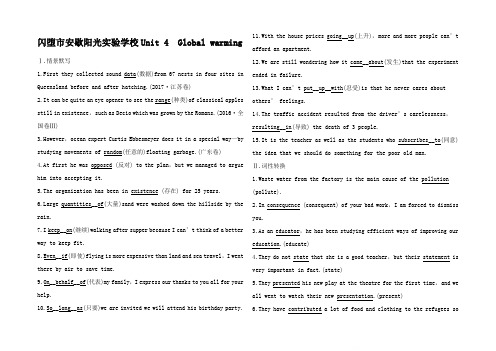
闪堕市安歇阳光实验学校Unit 4 Global warming Ⅰ.情景默写1.First they collected sound data(数据)from 67 nests in four sites in Queensland before and after hatching.(2017·江苏卷)2.It can be quite an eye opener to see the range(种类)of classical apples still in existence,such as Decio which was grown by the Romans.(2016·全国卷Ⅲ)3.However,ocean expert Curtis Ebbesmeyer does it in a special way—by studying movements of random(任意的)floating garbage.(广东卷)4.At first he was opposed (反对) to the plan,but we managed to argue him into accepting it.5.The organization has been in existence (存在) for 25 years.rge quantities__of(大量)sand were washed down the hillside by the rain.7.I keep__on(继续)walking after supper because I can’t think of a better way to keep fit.8.Even__if(即使)flying is more expensive than land and sea travel,I went there by air to save time.9.On__behalf__of(代表)my family,I express our thanks to you all for your help.10.So__long__as(只要)we are invited we will attend his birthday party.11.With the house prices going__up(上升),more and more people can’t afford an apartment.12.We are still wondering how it came__about(发生)that the experiment ended in failure.13.What I can’t put__up__with(忍受)is that he never cares about others’ feelings.14.The traffic accident resulted from the driver’s carelessness,resulting__in(导致) the death of 3 people.15.It is the teacher as well as the students who subscribes__to(同意) the idea that we should do something for the poor old man.Ⅱ.词性转换1.Waste water from the factory is the main cause of the pollution (pollute).2.In consequence (consequent) of your bad work,I am forced to dismiss you.3.As an educator,he has been studying efficient ways of improving our education.(educate)4.They do not state that she is a good teacher,but their statement is very important in fact.(state)5.They presented his new play at the theatre for the first time,and we all went to watch their new presentation.(present)6.They have contributed a lot of food and clothing to the refugees sofar and their contributions will certainly help them live through the winter.(contribute)7.The storm tends to hit our city,and we will observe the tendency of it closely.(tend)8.The air conditioners of this type consume too much electricity,which many consumers complain about.(consume)9.The situation of the economy of this area has become steady and the economy here will continue to develop steadily.(steady)10.Even though the growth__ of the crops is good,they still need rain to help grow better.(grow)1.句型公式:时间状语从句的省略我在上大学时就开始认识他,一个奇怪但有能力的学生。
2023高中英语重点短语归纳总结(高考复习必背)
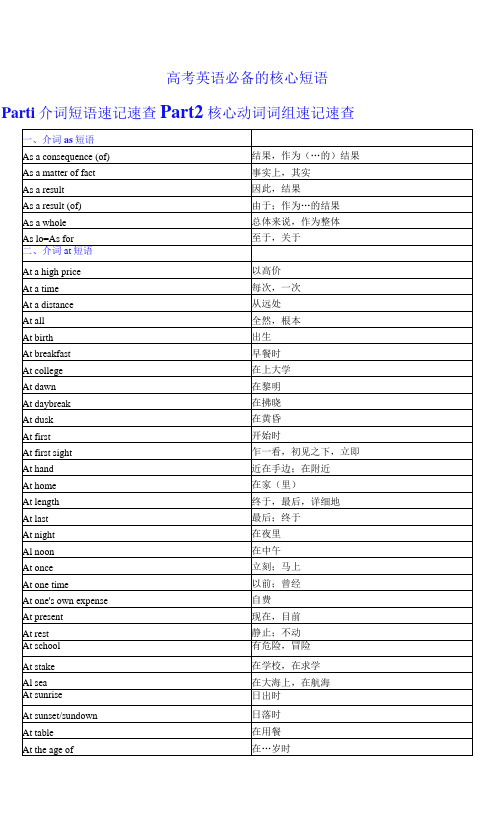
carry back拿|口|,运I可,使想起
carry ...into effect /practice执行,实行,实现,完成
carry off带走叼走,夺去…的生命,获得(奖品)
carry on坚持,继续,进行
carryout贯彻,执行,实施,完成
carry through坚持到底,进行到底,贯彻,完成
call off取消,下令停止call on拜访(某人),号召call out大声喊,唤起call to mind使想起,回忆起call up打电话给…,召集,使想起pay a call at sp.访问(某地pay a call on sb.拜访(某人)
7.以carry为中心的词组
carry about随身携带
a cut above胜过一筹
a short cut近路,捷径
cut a /the record创造新记录,打破记录
cut away切去,砍掉,逃走
cut down砍倒,削减,缩短
cut in half/into halves把...切成两半
cut in /into/to pieces把…切碎
culoff切断,中断,剪下,关掠
break one's promise失言
break ofT打断,断绝,折断,突然终止
break open破开,撬开
break short中断,折断
break through突破,克服,挤过去
break up vt.开垦,破碎:解散,分解vi.结束
4.以build为中心的词组
build ... into把…建设成,把…装入
come into operation开始运转,实施,生效come into possession of占有,拥有
高考英语 Unit 5 Travelling abroad课下作业高英语试题

落堕市安心阳光实验学校Unit 5 Travelling abroadⅠ.情景默写1.We can use honey to substitute (代替)for sweet.2.There is abundant (丰富的)firewood in the forest.3.In the cafeteria (自助餐厅)we serve ourselves.4.He was 38,and a confirmed bachelor (未婚男子).5.The distinction being made is purely academic (学术的).6.Children love to seek comfort (安慰)in their parents’ arms. 7.They are determined to carry forward the enterprise (事业).8.The extra language classes are entirely optional (可选择的).9.Within five minutes he had contradicted (反驳)himself twice. 10.Each of the U.S.states has an autonomous (自主的)government. 11.They sat down and drafted (草拟)a letter to the local newspaper. 12.Long queues (队列)are building up on most of Britain’s motorways. 13.We will not arrive at our destination (目的地)before dark unless we speed up.14.It was a few moments before his eyes adjusted_to (适应)the bright glare of the sun.15.Influenced by a high-school biology teacher,he took_up (开始从事)the study of medicine.16.He seemed to be_occupied_with (忙于)nothing but his food,his dogs,and his chickens.17.We were a little disorganized after the move and it was not until last week that we settled_in (安顿下来).18.Day_in_and_day_out (日复一日)you can hear them arguing about the same silly questions.19.There are so many applicants,so it is out_of_the_question (不可能的)that they will offer you the chance.20.What I am concerned about is whether they could fit_in (相适应)with society and how we can create more opportunities for them.Ⅱ.词性转换1.Our conclusions are always open to revision (revise)in the light of fresh evidence.2.As soon as he arrived,he made an apology (apologize)to his boss for being late.3.To the delight of the headmaster,the young teacher had all the qualifications (qualify)she hoped for.4.Not all goods can satisfy the customers’ requirements (require).5.We want an acknowledgement (acknowledge)of the existence of the problem.6.He occupies an important position in the government office,and his occupation brings him great fame.(occupy)7.A government is the group of people who are responsible for governing a country or state.(govern)8.Every family is busy preparing for the Spring Festival,for there are lots of preparations to do.(prepare)9.These new shoes are not very comfortable(comfort) though they are designed for comfort.10.The young man was recommended as a manager of the big company thanks to the recommendation letter of his professor.(recommend)1.句型公式:It is/was the first time (that)...意为“第一次……”我记得那是我第一次到电影院看电影。
高考英语一轮复习第一部分Unit4Sharing新人教版选修7

⾼考英语⼀轮复习第⼀部分Unit4Sharing新⼈教版选修7Unit 4 SharingⅠ.情景默写1.Many young people,most of whom were well-educated,headed for remote(遥远的)regions to chase their dreams.(2016·江苏卷)2.But the research has found laptop users are less able to remember and apply the concepts(概念)they have been taught.(辽宁卷)3.Sometimes I wonder if my teaching is relevant (有关的) to the future of the students.4.When young,they all dreamed of becoming astronauts (宇航员).5.My uncle purchased (购买) a new house near the lake last year.6.The typhoon swept the roofs(屋顶)of many houses,causing great damage to the local people.7.As soon as the new textbooks(教科书)reached the students,they could not wait to read them.8.During the drought,the river dried__up (⼲涸); as a result,many fish died.9.I heard__from (收到……信) my cousin yesterday,saying that he would come to visit us the next week.10.Helen borrowed my book the__other__day (不久前的⼀天),saying that she would return it soon.11.They are the ones who help you out when you are in__need (在困难中).12.It’s clear that the young American is__dying__to(渴望)learn Chinese from you.13.In summer,water the plants regularly and never let the soil dry__out (⼲透). Ⅱ.词性转换1.What he needs is the security (secure) of a happy home.2.You’d better not walk into the room with muddy (mud) boots on your feet.3.The doctor said he was a volunteer,who had participated in many voluntary activities.(volunteer)4.They encouraged the participants to participate in the singing performance after the contest and their participation gave the students much delight.(participate)5.We donate to the school fund every year,and the donation is given to those in need.(donate)6.The operator is operating the big machine according to the operation guidance.(operate)7.The desks and chairs are adjustable and you can adjust them to the height of the students.The adjustment is not difficult to make.(adjust)8.His property was distributed among his sons.But unexpectedly,they had a conflict about the distribution.(distribute)1.句型公式:be doing...when...昨天下午我正在街上散步,这时我碰到了我的英语⽼师。
英语选择性必修二步步高学习笔记电子版
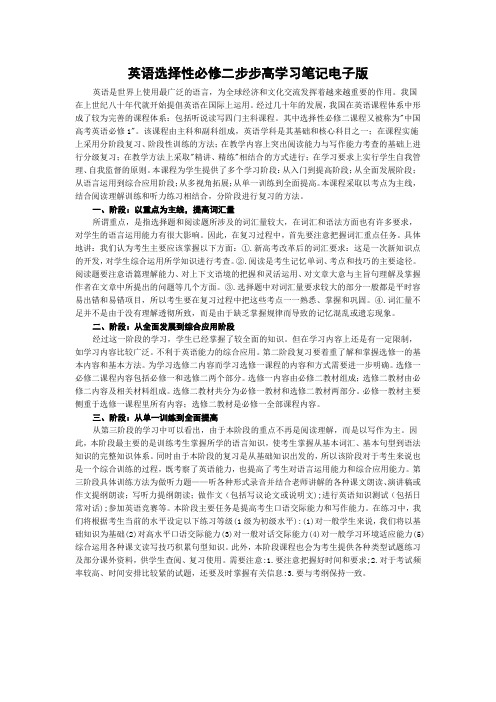
英语选择性必修二步步高学习笔记电子版英语是世界上使用最广泛的语言,为全球经济和文化交流发挥着越来越重要的作用。
我国在上世纪八十年代就开始提倡英语在国际上运用。
经过几十年的发展,我国在英语课程体系中形成了较为完善的课程体系:包括听说读写四门主科课程。
其中选择性必修二课程又被称为"中国高考英语必修1"。
该课程由主科和副科组成,英语学科是其基础和核心科目之一;在课程实施上采用分阶段复习、阶段性训练的方法;在教学内容上突出阅读能力与写作能力考查的基础上进行分级复习;在教学方法上采取"精讲、精练"相结合的方式进行;在学习要求上实行学生自我管理、自我监督的原则。
本课程为学生提供了多个学习阶段:从入门到提高阶段;从全面发展阶段;从语言运用到综合应用阶段;从多视角拓展;从单一训练到全面提高。
本课程采取以考点为主线,结合阅读理解训练和听力练习相结合,分阶段进行复习的方法。
一、阶段:以重点为主线,提高词汇量所谓重点,是指选择题和阅读题所涉及的词汇量较大,在词汇和语法方面也有许多要求,对学生的语言运用能力有很大影响。
因此,在复习过程中,首先要注意把握词汇重点任务。
具体地讲:我们认为考生主要应该掌握以下方面:①.新高考改革后的词汇要求:这是一次新知识点的开发,对学生综合运用所学知识进行考查。
②.阅读是考生记忆单词、考点和技巧的主要途径。
阅读题要注意语篇理解能力、对上下文语境的把握和灵活运用、对文章大意与主旨句理解及掌握作者在文章中所提出的问题等几个方面。
③.选择题中对词汇量要求较大的部分一般都是平时容易出错和易错项目,所以考生要在复习过程中把这些考点一一熟悉、掌握和巩固。
④.词汇量不足并不是由于没有理解透彻所致,而是由于缺乏掌握规律而导致的记忆混乱或遗忘现象。
二、阶段:从全面发展到综合应用阶段经过这一阶段的学习,学生已经掌握了较全面的知识。
但在学习内容上还是有一定限制,如学习内容比较广泛。
(浙江专用版)高考英语大一轮复习 第一部分 Unit 2 The United Kingdom课下作
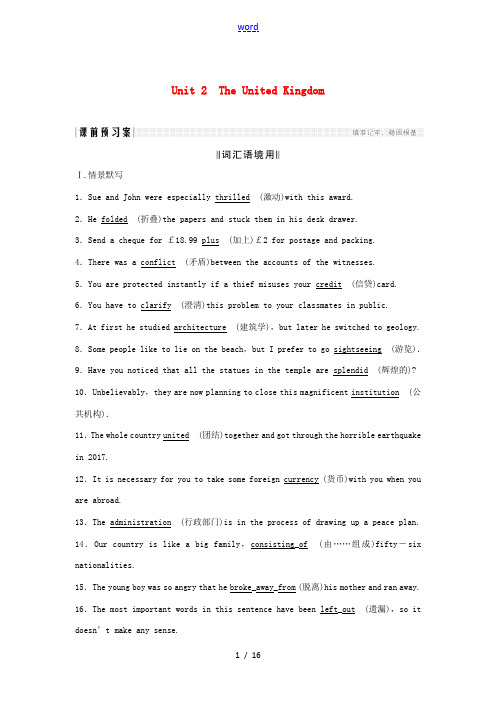
Unit 2 The United KingdomⅠ.情景默写1.Sue and John were especially thrilled (激动)with this award.2.He folded (折叠)the papers and stuck them in his desk drawer.3.Send a cheque for £18.99 plus (加上)£2 for postage and packing.4.There was a conflict (矛盾)between the accounts of the witnesses.5.You are protected instantly if a thief misuses your credit (信贷)card. 6.You have to clarify (澄清)this problem to your classmates in public.7.At first he studied architecture (建筑学),but later he switched to geology. 8.Some people like to lie on the beach,but I prefer to go sightseeing (游览).9.Have you noticed that all the statues in the temple are splendid (辉煌的)? 10.Unbelievably,they are now planning to close this magnificent institution (公共机构).11.The whole country united (团结)together and got through the horrible earthquake in 2017.12.It is necessary for you to take some foreign currency (货币)with you when you are abroad.13.The administration (行政部门)is in the process of drawing up a peace plan. 14.Our country is like a big family,consisting_of (由……组成)fifty-six nationalities.15.The young boy was so angry that he broke_away_from (脱离)his mother and ran away. 16.The most important words in this sentence have been left_out (遗漏),so it doesn’t make any sense.17.It is much to_her_credit (值得赞扬)that Mary continued to work in spite of all the difficulties.18.The professor has suddenly fallen ill.Who can take_the_place_of (代替)him to give the lecture?19.The town was named after Mr.Smith,in_memory_of (纪念)his great contributions to its development.20.The printing machines are always breaking_down (损坏),which annoys him a lot. Ⅱ.词性转换1.This job doesn’t pay well,but it’ll roughly (rough)cover your daily expenses. 2.We recognized the possibility (possible)and took steps to prevent it happening. 3.His father’s collection (collect)of ancient coins will be displayed nationwide. 4.Your suggestion has greatly contributed to the accomplishment (accomplish)of our work.5.Men are anxious to improve their circumstances,but they are unwilling (will)to improve themselves.6.It’s very convenient for me to ring you up.There is a convenience store near my home.(convenient)7.Two days later,I was delighted to hand in all of my work on time,to my teacher’s delight.(delight)8.Our department will be in charge of arranging the conference.Would you please give us some suggestions on the arrangement for it? (arrange)9.He described the robbery in detail to the policeman and his description was very valuable—the police caught the robber in a short time.(describe)10.What attracts me most in Beijing is that there are many attractions,like the Great Wall,the Summer Palace.They are so attractive as to attract eyes from every corner of the world.(attract)1.句型公式:“find+sb./sth.+过去分词〞结构你会发现全世界都为他感到兴奋。
英语技巧总结

英语答题技巧总结听力高考英语听力测试部分在整套试题中占有重要地位。
它要求考生从头到尾按顺序往下听,在有限的时间内做出选择,没有“回头看”的余地。
今天,小简老师就结合近几年高考英语听力试题介绍一些应试技巧和解题的基本方法。
一.听力应试技巧与策略听前:略读题目,切入话题,划出重点,预测内容(确定人物身份)听中:捕捉信息,速记要点,有的放矢,去伪存真(短文独白,首末为主旨句,注意5W,1H)听后:连贯记忆,前后联系,综合考虑,一锤定音。
二.快速记录能力心记:这种能力对于解决听力第1节的问题非常适用。
笔记:1)运用速记符号例如:↑up↓down←left→right=equal2)发明并运用字母的缩写形式Ex——expensive lg——large eq——earthquake三.预测技巧1.对话预测:在听取对话,尤其是Part1-5——Short Conversation时,考生可以按照下例wh-问题进行预测:1)Who are the two speakers?2)What is the possible Relationships between them?3)When did they have the conversation?4)Where did the conversation take place?5)Why do they have the conversation?6)What did they plan to do?2.语篇预测:了解讲话者已提供和未提供的信息1)What facts did the speaker offer?2)What facts did the speaker fail to offer?3.依靠开篇句预测:英语听力的第一句话通常会透露整篇的主题,所以考生要善于抓住听力材料的首句信息。
”例如:Americans have a popular saying “Time is money从这一句开篇句我们可以预测的信息范围:1)这是一篇关于时间的话题。
746 高考真题解析:第一部分 必修五 Unit 3

Unit 3Life in the futureⅠ.单词默写1.The real museum lacked(缺乏) enough artwork to interest her.(2018·天津卷) 2.Moran says one of the problems with jazz today is that the entertainment aspect(方面)of the music has been lost.(2017·全国卷Ⅰ)3.It had white-painted tunnels and bright red carriages(客车),and proved extremely popular with the public.(2017·全国卷Ⅱ)4.They recycle(回收利用)their garbage because they care about the environment.(重庆卷)5.Drayton is optimistic(乐观的)that in ten years Ashoka will be making really serious,practical progress.(安徽卷)6.If you tolerate (容忍) a person,you accept him although you do not particularly like him.7.More young people are making the switch (转换) to microblog job seeking. 8.We are taking off now.Please fasten (系牢) your safety belt.9.The shop assistant guided (引导) me to the shelf where the gardening books were displayed.10.He is greedy (贪婪的) for wealth while she is dying for health.Ⅱ.词性转换1.The city of Hangzhou is really an impressive place.Especially the famous West Lake always leaves quite an impression on the visitors.I was strongly impressed by its beauty the first time I saw it.(impress)2.I always dream of having a house surrounded by trees and flowers.If we can live in such beautiful surroundings,we must have a happy feeling every day.The surrounding things always have an effect on our moods.(surround)3.An adjustment can be made to these desks and seats;if you follow the instruction,it is quite easy to adjust them properly.(adjust)4.The firm is pressing me for a decision and the pressure from my parents is quite unbearable,so I had to accept this new job.(press)5.An official was sent to settle the problem but different opinions of two sides destroyed all the hopes of a peaceful settlement.(settle)6.It is more complicated than we previously (previous) thought.7.As I walked by the town,I was constantly (constant) reminded of my childhood. 8.I was so familiar with him that I recognized his voice instantly (instant) I picked up the phone.Ⅲ.短语填空1.Tom thought carefully for several days and decided to take__up(从事)the job. 2.Nobody noticed when he entered the classroom; he slid__into(溜进)it from the back door.3.She showed a__lack__of(缺少)responsibility,so she lost the good opportunity. 4.Don’t leave her alone to sweep__up(打扫)the house after the party.5.Many countries are faced with the problem about how to speed__up(加速)economic development.6.I watched the plane go higher and higher until I lost__sight__of (看不见)it.1.句型公式:the moment when...我仍然记得我们一起赏月的时刻。
高考英语核心1783词汇笔记-分课次
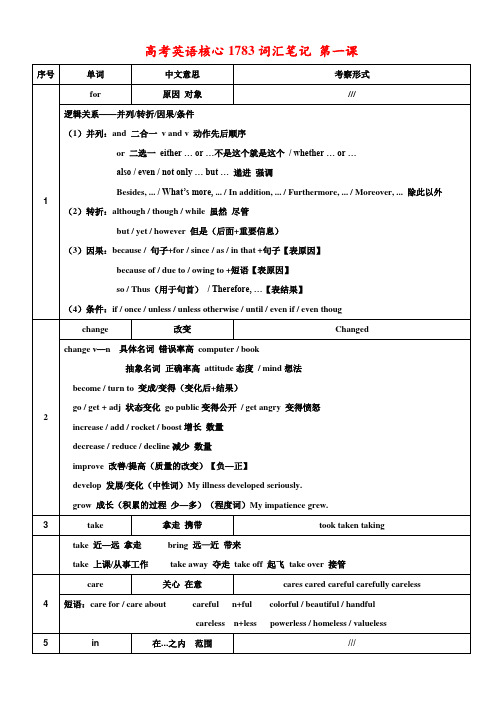
interest
兴趣
interestedinterestinginterests
be interested in感兴趣be keen on sth.热衷be enthusiastic with sth. / be passionate for sth.热爱
14
surprise
惊讶
surprisedsurpriseessurprising
(2)discourage沮丧depress情绪低落【dis-否定】
sad / unhappy –discouraged /depressed不开心
happy –delighted开心
12
hope
希望
Hoped hoping hopeful hopefully hopeless
hope / wish to do sth. == want to do sth.想做某事
courage n.勇气(遇到困难时)adj. courageous
bravery n.勇敢(遇到危险时)adj. brave
(1)encourage鼓励en-/-en使动用法broaden / widen our horizons拓宽视野
strengthen our abilities / skills增强能力enrich our daily life丰富生活
改变
Changed
change v—n具体名词错误率高computer / book
抽象名词正确率高attitude态度/ mind想法
become / turn to变成/变得(变化后+结果)
go / get + adj状态变化go public变得公开/ get angry变得愤怒
高考英语一轮复习 第一 Module 1 Life in the Future

入舵市安恙阳光实验学校Module 1 Life in the FutureⅠ.情景默写1.He hated being in the army because he had to obey commands(命令) here.2.I won’t go there again.They are too greedy—they charged(要价) me 15 pounds for the broken cup.3.Faced with so heavy snow,I had no alternative(选择) but to stay at home watching TV programs.4.I have this image of you as always being cheerful and optimistic(乐观的).5.Eventually(最终) your child will leave home to lead her own life asa fully independent adult.6.You can definitely(无疑地) save a lot of money by buying a cheaper one instead.7.They have designed a new type of car shaped(使成形) like a spider.8.A small boat loaded(装载) with laughter slowly drew near,and stopped beside the bridge.9.It is advisable that you should attach(附上) a recent photo of yours to your application form.10.It is predicted(预测) that robots will do most of the housework in about 50 years.11.It is reported that several people in connection with a robbery have been arrested(逮捕).12.No one knows for sure(肯定地)when advertising first started.13.The young man made up his mind to get rid of(戒除) his bad habits.14.We’d almost finished solving the problem when our time ran out/was used up(用光).15.You can’t just rely on(依靠)your parents lending you the money.Ⅱ.词性转换1.They predicted that there would be an earthquake,but their prediction didn’t come true.(predict)2.The little boy tried to save his sister from the river at the risk(risky) of his own life,which is quite risky.3.Nowadays we rely increasingly on computers for help so your software must be reliable(rely).4.It is bad manners to laugh at disabled people.Most of us may end up in disability one day.(disable)5.As a criminal, the boy who was charged with the crime had shown criminal tendencies since early adolescence.(crime)6.Mary is an optimistic girl and she believes optimism(optimistic) can create miracles(奇迹).7.I definitely(definite) remember sending the letter and I’m definite about this.1.句型公式:动名词作主语踢足球是他的业余爱好之一。
2023年高考英语(北京卷)试题评析(权威发布)
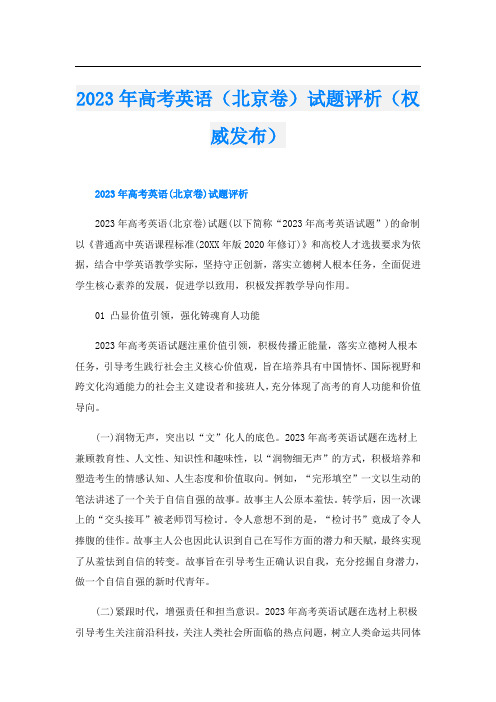
2023年高考英语(北京卷)试题评析(权威发布)2023年高考英语(北京卷)试题评析2023年高考英语(北京卷)试题(以下简称“2023年高考英语试题”)的命制以《普通高中英语课程标准(20XX年版2020年修订)》和高校人才选拔要求为依据,结合中学英语教学实际,坚持守正创新,落实立德树人根本任务,全面促进学生核心素养的发展,促进学以致用,积极发挥教学导向作用。
01 凸显价值引领,强化铸魂育人功能2023年高考英语试题注重价值引领,积极传播正能量,落实立德树人根本任务,引导考生践行社会主义核心价值观,旨在培养具有中国情怀、国际视野和跨文化沟通能力的社会主义建设者和接班人,充分体现了高考的育人功能和价值导向。
(一)润物无声,突出以“文”化人的底色。
2023年高考英语试题在选材上兼顾教育性、人文性、知识性和趣味性,以“润物细无声”的方式,积极培养和塑造考生的情感认知、人生态度和价值取向。
例如,“完形填空”一文以生动的笔法讲述了一个关于自信自强的故事。
故事主人公原本羞怯。
转学后,因一次课上的“交头接耳”被老师罚写检讨。
令人意想不到的是,“检讨书”竟成了令人捧腹的佳作。
故事主人公也因此认识到自己在写作方面的潜力和天赋,最终实现了从羞怯到自信的转变。
故事旨在引导考生正确认识自我,充分挖掘自身潜力,做一个自信自强的新时代青年。
(二)紧跟时代,增强责任和担当意识。
2023年高考英语试题在选材上积极引导考生关注前沿科技,关注人类社会所面临的热点问题,树立人类命运共同体意识,增强责任感、紧迫感和使命感。
例如,在阅读C篇一文中,作者指出了西方在工业化进程中因短视所带来的种种问题。
这启发人们要用发展的眼光看问题,从一个侧面反映了当今社会实现高质量发展的现实意义和价值。
*也有助于考生树立人类命运共同体意识,从全球的视角观察和认识世界。
阅读D篇探讨了人工生命这一科学前沿问题,旨在引导考生拓宽视野,关注经济社会发展的新变化,关注科学技术进步的新成果,为未来参与知识创新和科技创新奠定基础,为实现国家高水平科技自立自强贡献力量。
广东英语春季高考知识点
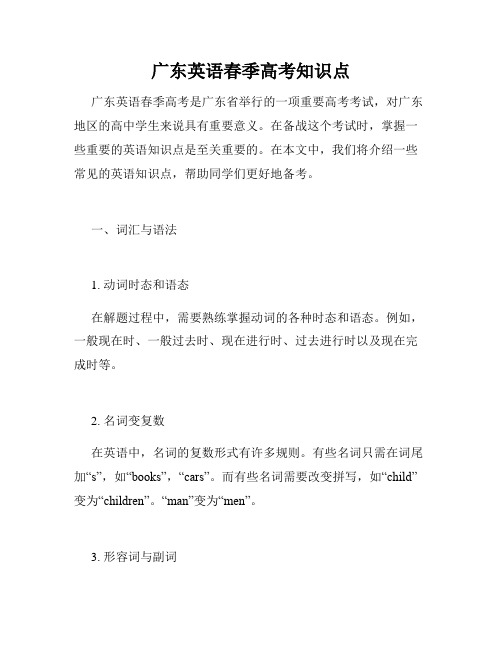
广东英语春季高考知识点广东英语春季高考是广东省举行的一项重要高考考试,对广东地区的高中学生来说具有重要意义。
在备战这个考试时,掌握一些重要的英语知识点是至关重要的。
在本文中,我们将介绍一些常见的英语知识点,帮助同学们更好地备考。
一、词汇与语法1. 动词时态和语态在解题过程中,需要熟练掌握动词的各种时态和语态。
例如,一般现在时、一般过去时、现在进行时、过去进行时以及现在完成时等。
2. 名词变复数在英语中,名词的复数形式有许多规则。
有些名词只需在词尾加“s”,如“books”,“cars”。
而有些名词需要改变拼写,如“child”变为“children”。
“man”变为“men”。
3. 形容词与副词形容词和副词的使用要根据具体的语境和句子结构来决定。
形容词用于修饰名词,副词则用于修饰动词、形容词或其他副词。
4. 介词和冠词介词和冠词在句子中的使用非常重要,它们可以帮助我们表达时间、地点、方向和关系等概念。
例如,preposition of place,“in”表示在某地,“on”表示在某物上,“at”表示在某点。
二、阅读理解阅读理解是考试中的重要环节,需要提前做好针对性的练习。
在解题时,可以采用先看题干再读文章的方法,帮助捕捉关键信息,减少阅读的难度。
1. 核心思想阅读理解的核心是理解文章的主旨和中心思想。
可以通过读取开头和结尾的段落,以及每个段落的首尾句子,来捕捉文章的主要信息。
2. 细节题细节题是需要在文章中找到具体信息的问题,需要仔细阅读文章,定位关键词,寻找答案。
可以通过划线、做笔记等方式辅助解题。
3. 推理题推理题是需要根据文章中的信息进行推理、推断的问题。
在解题时,可以根据文章中的线索,结合自己的知识和常识,合理推测答案。
三、写作技巧写作是广东英语春季高考的另一个重要部分,需要考生对一定的写作技巧有所掌握。
以下是一些写作技巧的建议。
1. 开头和结尾写作的开头和结尾是考试中最容易出彩的部分。
青柠时光高考英语学霸笔记怎么样

《青柠时光高考英语学霸笔记怎么样》一、背景介绍青柠时光是一家专注于高考英语学习的机构,旨在帮助学生提高英语学习能力,取得优异的高考成绩。
其中,青柠时光高考英语学霸笔记作为其核心教学产品,备受学生和家长的关注。
本文将对青柠时光高考英语学霸笔记进行全面评价,并分析其优势和不足。
二、深度评估1. 内容深度青柠时光高考英语学霸笔记内容涵盖了高考英语所需的所有知识点,从听力、阅读、写作到翻译等各个方面进行了详细讲解。
每个知识点都有配套的练习题和答案,以帮助学生更好地掌握知识。
2. 学习方法青柠时光高考英语学霸笔记注重培养学生的学习方法,为学生提供了科学、高效的学习路线。
通过系统的学霸笔记,学生可以更好地掌握学习技巧和策略,提高学习效率。
三、广度评估1. 综合能力青柠时光高考英语学霸笔记不仅注重英语基础知识的传授,更注重培养学生的英语综合能力。
通过大量的实战题目和考试模拟训练,学生可以在真实的考试环境中不断提升自己的应试能力。
2. 学习环境青柠时光提供了良好的学习环境和氛围,包括优秀的师资力量和一流的教学设施。
学生可以在这样的环境中更好地学习和成长。
四、个人观点青柠时光高考英语学霸笔记在深度和广度上都具有很强的优势,能够帮助学生全面提高英语水平,在高考中取得更佳的成绩。
青柠时光注重学生的学习方法和能力培养,有助于学生在学习过程中形成科学的学习方式和健康的学习习惯。
我个人认为,青柠时光高考英语学霸笔记是一款值得信赖的学习辅助工具,能够为学生的英语学习之路提供有力的支持和帮助。
总结:通过对青柠时光高考英语学霸笔记的深度和广度评估,我们可以得出结论,这款产品具有非常强大的学习资源和教学力量,能够有效帮助学生提高英语学习水平,并在高考中取得优异的成绩。
青柠时光高考英语学霸笔记也注重学生的学习方法和综合能力培养,有助于学生在学习过程中形成科学的学习方式和全面的学习能力。
我强烈推荐青柠时光高考英语学霸笔记,相信它能够为广大学生带来更好的学习体验和更优异的学习成绩。
高考英语阅读高分冲刺2022年真题D篇技法讲义
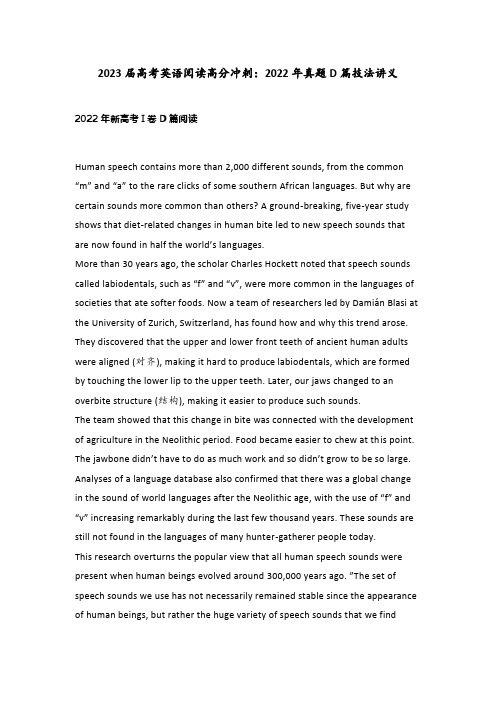
2023届高考英语阅读高分冲刺:2022年真题D篇技法讲义2022年新高考I卷D篇阅读Human speech contains more than 2,000 different sounds, from the common “m” and “a” to the rare clicks of some southern African languages. But why are certain sounds more common than others? A ground-breaking, five-year study shows that diet-related changes in human bite led to new speech sounds that are now found in half the world’s lan guages.More than 30 years ago, the scholar Charles Hockett noted that speech sounds called labiodentals, such as “f” and “v”, were more common in the languages of societies that ate softer foods. Now a team of researchers led by Damián Blasi at the University of Zurich, Switzerland, has found how and why this trend arose. They discovered that the upper and lower front teeth of ancient human adults were aligned (对齐), making it hard to produce labiodentals, which are formed by touching the lower lip to the upper teeth. Later, our jaws changed to an overbite structure (结构), making it easier to produce such sounds.The team showed that this change in bite was connected with the development of agriculture in the Neolithic period. Food became easier to chew at this point. The jawbone didn’t have to do as much work and so didn’t grow to be so large. Analyses of a language database also confirmed that there was a global change in the sound of world languages after the Neolithic age, with the use of “f” and “v” incre asing remarkably during the last few thousand years. These sounds are still not found in the languages of many hunter-gatherer people today.This research overturns the popular view that all human speech sounds were present when human beings evolved around 300,000 years ago. ”The set of speech sounds we use has not necessarily remained stable since the appearance of human beings, but rather the huge variety of speech sounds that we findtoday is the product of a complex interplay of things like biological change and cultural evolution,“ said Steven Moran, a member of the research team.32. Which aspect of the human speech sound does Damián Blasi’s research focus on?A. Its variety.B. Its distribution.C. Its quantity.D. Its development.33. Why was it difficult for ancient human adults to produce labiodentals?A. They had fewer upper teeth than lower teeth.B. They could not open and close their lips easily.C. Their jaws were not conveniently structured.D. Their lower front teeth were not large enough.34. What is paragraph 5 mainly about?A. Supporting evidence for the research results.B. Potential application of the research findings.C. A further explanation of the research methods.D. A reasonable doubt about the research process.35. What does Steven Moran say about the set of human speech sounds?A. It is key to effective communication.B. It contributes much to cultural diversity.C. It is a complex and dynamic system.D. It drives the evolution of human beings.体裁:说明文主题语境人与社会--历史、社会与文化(社会进步与人类文明)长度331词【语篇导读】本篇是一篇说明文。
蜜谱市嫩翠学校高考英语 第一 Unit 1 A land of diversity课下作业
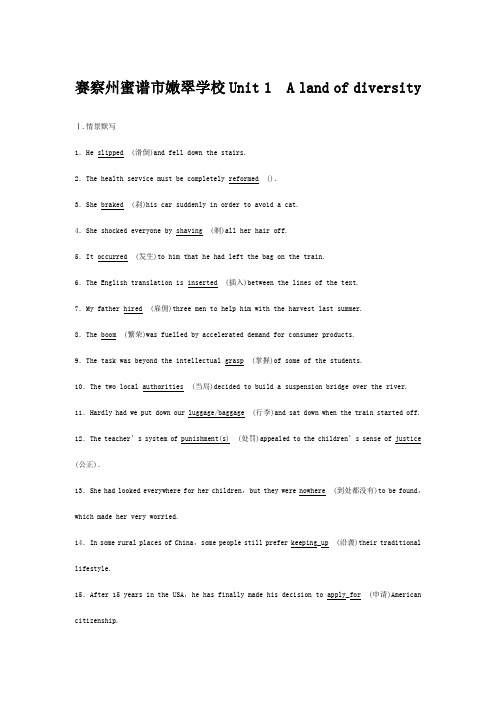
赛察州蜜谱市嫩翠学校Unit 1 A land of diversity Ⅰ.情景默写1.He slipped (滑倒)and fell down the stairs.2.The health service must be completely reformed ().3.She braked (刹)his car suddenly in order to avoid a cat.4.She shocked everyone by shaving (剃)all her hair off.5.It occurred (发生)to him that he had left the bag on the train.6.The English translation is inserted (插入)between the lines of the text.7.My father hired (雇佣)three men to help him with the harvest last summer.8.The boom (繁荣)was fuelled by accelerated demand for consumer products.9.The task was beyond the intellectual grasp (掌握)of some of the students.10.The two local authorities (当局)decided to build a suspension bridge over the river. 11.Hardly had we put down our luggage/baggage (行李)and sat down when the train started off. 12.The teacher’s system of punishment(s) (处罚)appealed to the children’s sense of justice (公正).13.She had looked everywhere for her children,but they were nowhere (到处都没有)to be found,which made her very worried.14.In some rural places of China,some people still prefer keeping_up (沿袭)their traditional lifestyle.15.After 15 years in the USA,he has finally made his decision to apply_for (申请)American citizenship.16.While you are reading an article,you’d better mark_out (标出)the key words and topic sentences.17.Pity! You didn’t listen to my advice;otherwise,you would not have been taken_in (欺骗).18.You can team_up_with (与……合作)one other class member if you can’t f inish it on time. 19.It is honorable to make_a_life (谋生)with your hands while depending on others is a shame. 20.The police looked into the case carefully and found the thief had entered the house by_means_of (借助于)a ladder.Ⅱ.词性转换1.The area has a high percentage (percent)of unemployed men.2.They believed that these problems would disappear under socialism (social).3.He won the election and was elected president of the country.(elect)4.Apparently,she took no notice of the apparent mistakes in the accident.(apparent) 5.“Walk across this street and turn left at the first crossing(cross).” the boy told the lady. 6.He indicated that an indicator should give me some indications of how I did in the test.(indicate) 7.The results of the survey fell into distinct groups.The old were scholars of great distinction while the young were the opposite.(distinct)8.All the applicants can apply in person or by letter and at the same time should hand in their applications before May 6th.(apply)9.One of the major problems is that a majority of the graduates who major in English find it difficult to find a good job.(major)10.If a customer wants to bring the goods he buys abroad back to inland,he has to pay some customs when he passes through the customs.(custom)1.句型公式:it is likely that...意为“很可能……”很可能有一些像地球一样的星球,在那里也可能存在生命。
- 1、下载文档前请自行甄别文档内容的完整性,平台不提供额外的编辑、内容补充、找答案等附加服务。
- 2、"仅部分预览"的文档,不可在线预览部分如存在完整性等问题,可反馈申请退款(可完整预览的文档不适用该条件!)。
- 3、如文档侵犯您的权益,请联系客服反馈,我们会尽快为您处理(人工客服工作时间:9:00-18:30)。
高考英语阅读理解核心笔记“阅读理解不是考你看完文章之后答出五道题,而是通过五道题看你能否读懂这篇文章!”阅读理解的主要题型一、主旨大意(一)常见的提问方式:(1) The best title/headline for this passage is _______.(2) The passage (or the first paragraph) is mainly about ________.(3) What is the main idea/topic/purpose/subject of the passage?(4) Which of the following titles best summarizes the main idea of the passage?(5) The passage chiefly discusses/deals with ________.(6) Which of the following best states the theme of the passage?(7) What topic is treated in the passage?(8) The passage makes clear that ________.(9) Which of the following best sum up the passage?(二)怎样挖掘文章主旨1、依照中心词确定主题。
2、抓住主题句来确定主题(1)识别主题句与细节① raises some farm animals.② has 30 cows, about 300 hens and he keeps some pigs as well.(2)主题句的定位(分析文章结构)①开门见山,点出主题(主题句出现在开头)②详细论证,总结陈词(主题句出现在结尾)③引题过渡,引出主题(主题句出现在中间)(三)技巧及注意事项(1)无论它出现在题目当中哪个位置,都建议作为最后一道题去做,因为做完其它题目以后会对主旨的理解有帮助。
(2)主旨在文章中间时,遇到文章前后段意思转折,要提高警惕。
(3)首段出现疑问句时,对该问题的解答就是文章主旨。
(4)正确选项不出现细节信息,不含过分肯定和绝对意义的词,覆盖面不能过大也不能过小。
二、细节理解(一)常见的提问方式:(1) Which of the following is NOT included/ mentioned in the passage?(2) Which of the following (sentences /statements) is NOT true?(3) According to the passage, all of the following are true except/but _____.(4) Choose the right order of the events given in the passage.(5) Which of the following maps/diagrams gives the right position of…?(6) Which of the drawings below gives an idea of what …is like?(二)常见的细节理解题型及解题方法:1)排序题。
方法:“首尾定位法”(找出第一个动作和最后的一个动作,缩小选择范围)2)图形辨认题方法:“按文索图法”(找出描绘图形的句段,进行文图对照)3)数字换算题方法:“列表推算法”(找出与题干相关的数据列表或推算)4)表格理解题方法:“文表分析法”(把题干、选项与表格对照分析)5)应用广告类事实信息题方法:“题干定位法”(直接阅读题干,在文中找答案,不必阅读全文)(三)技巧及注意事项(1)命题者往往通过改变或去掉特定的修饰语(all, every, always, never, completely, altogether 等),使信息范围,程度,色彩发生细微变化,从而导致考生误选。
(扩缩范围干扰法)(2)注意顺藤摸瓜,在文章中找到句子,通常不可能与阅读材料完全一样,而是换用不同的表达方式。
(词义转换+语义转换)三、推理判断(一)常见的提问方式:(1) We can know from the passage that ______.(2) We can infer from the (first/last) passage that ______.(3) The passage implies that ________.(4) The passage suggests that _________.(5) It can be concluded from the passage that _______.(6) The underlined sentence indicates that _______.(7) From the passage we can draw the conclusion that ______.(二)怎样做出推理判断此题型是阅读理解中较难的题型,属于深层次理解题。
在试卷中数量不断增多,有时会达到阅读理解试题的一半左右。
它要求考生根据上下文的内在联系,充分挖掘文章的深层次内涵。
做这类题时要注意:在解答推理性问题时,应清楚所要解答的问题是针对某个细节进行推断,还是针对主题思想、作者的意图进行推断。
针对细节的推断可运用scanning方法,迅速在阅读材料中确定推理依据的位置或范围,然后再进行推理判断。
针对主题思想作推断时,其解题的主要依据是文章的主题思想,然后再分析句子之间的逻辑关系,区分观点与例证(opinion and fact)、原因与结果(cause and effect)、主观点与次观点(main idea and supporting idea)。
(三)技巧及注意事项(1)正确选项并非对原文的简单复述,而是作者在文章中没有提到的,没有明说的,或者可能发生的事实,勿把直接表达当作间接推理。
(2)注意文章中含义深刻或结构复杂的句子,考生对作者表达的意思能不能一下子看懂,也是命题点所在。
四、作者意图(态度)(一)这种题型常见的提问方式:(1) The author seems to be in favor of / against ______.(2) The author’s purpose of writing this passage is _______.(3) The author may probably agree with/ support _______.(4) What’s the author’s attitude /viewpoint towards _______?(5) How does the author feel about ________?(6) The author implies that _______. The author gives the impression that ________.(8) In the author’s opinion, ________.(9) The tone of the author may be _______.(二) 怎样揣摩作者的意图或态度要吃透文章,就要搜索文章的关键字眼和关键句子,要熟悉各种文体,尤其要把握作者的语气,是严肃或轻松,幽默或讽刺,平和或激动,乐观或悲观等等。
此外,还要注意文章中一些细节性的用词,如however, even though, but 等连接词往往和作者的态度有关。
表示褒义的有:乐观的optimistic;赞美的praising;自信的confident;赞成的favorable;积极的positive;认真的serious;负责的 responsible, dutiful,令人信服的 convincing。
表示贬义的有:讽刺的ironic;厌恶的disgusted;否定的/反对的negative;怀疑的suspicious;沮丧的depressed;痛苦的bitter;悲观的pessimistic;不负责的irresponsible;无法预料的unforeseeable。
表示中性的:中立的neutral;冷淡的 indifferent;主观的subjective;客观的objective;不动感情的impassive另一种方法是靠文章的结构特点来判断,如果一篇文章的结尾部分是并列的疑问,则作者是一种客观的态度,如果结尾部分是有问有答的形式,则作者的态度是主观的态度。
如果一篇文章的结尾部分使用数据表明了一个趋势向不好的方面发展,则作者是悲观的态度。
反之,作者是乐观的态度。
(三)技巧及注意事项(1)不要把自己的态度揉入其中,也要区分作者的态度和作者引用别人的态度(2)当作者的态度没有明确提出时,要学会根据作者使用词语的褒贬性去判断.五、猜测词义(一)常见的提问方式:(1) The word “…”in the passage means______.(2) The word “…” could be best replaced by _____.(3) Which of the following is nearest/closest in meaning to _______.(4) The word “…” probably refers to ______.(5) According to the passage, the word “…” is known as ______.(二)技巧及注意事项(1)切记:无论这个词多超纲,根据上下文都能得出其意思;无论这个词多熟悉,都要通过上下文得出其在特定场合的意思。
(2)正确选项通常不是熟词的常规含义(三)解题常用方法Ⅰ针对性的解释针对性解释是作者为了更好的表达思想,在文章中对一些重要的概念、难懂的术语或高深的词汇等所做的通俗化的解释。
这些解释提供的信息明确具体,所使用的语言通俗易懂,利用它们来猜测词义就非常简单。
1.根据定义(definition)猜测词义如果生词有一个句子(定语从句或是同位语<同位语前常有 or, similarly, that is to say, in other words, namely, or other, say, . 等>或是同位语从句)或段落来定义,或使用破折号,冒号,分号后的内容和引号括号中的内容加以解释和定义,那么理解这个句子或段落本身就是推断词义。
